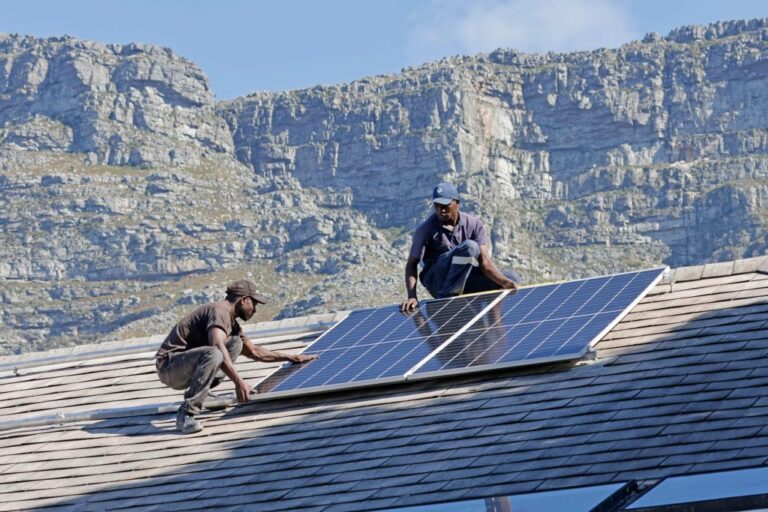For the remainder of the week, Eskom has announced that load shedding will be suspended between 10am and 4pm. How could this be? If load shedding is a result of the shortfall in generation capacity, how can we suddenly not have load shedding during the day?
The answer, rather logically, is private-sector solar.
ADVERTISEMENT
CONTINUE READING BELOW
By its own estimates, Eskom has 5 200MW of what it terms “rooftop photovoltaic (PV)”. It uses normalised demand in an area in normal weather to calculate how much demand is foregone once solar PV is installed in a neighbourhood, office park or estate.
As of Wednesday, there is an – at least – 1 000MW practically guaranteed divergence between the supply before the sun actually starts beating down and later in the day. This has been in place for quite some time, where load shedding has been implemented at a reduced stage during the day.
However, when the generation shortfall is ‘only’ around 1 000MW and solar PV boosts generation way beyond this figure during daylight hours, it becomes possible to suspend load shedding, as has been the case during recent weeks.
In the past, the pattern has been a ‘reduction’ in the severity of load shedding from, say, Stage 4 to Stage 3. In recent days, there hasn’t been an instance of solar PV generating less than 1 300MW during daylight hours from 9am, as contracted to Eskom.
It has 2 287.1MW of independent power producer (IPP) capacity to call on.
At this rate, its capacity factor is around 30% on average (maybe 25%), which means Eskom could call on an average of around 500MW throughout the day. Solar doesn’t work this way, which is why batteries, concentrated solar power and pumped storage (effectively a battery) are the answer to solar’s rather limited contribution during the day to stretch supply beyond just the peak daylight hours.
Read: Home, business solar installs doubled to 5GW last year
Still, given that Eskom estimates that there is over 5 000MW of solar PV installed and commissioned, at a capacity factor of 25%, this equates to over 1 250MW, consistent with the lived experience of South Africans as load shedding begins to ease.
It is therefore not surprising that Eskom is beginning to bank on this power going forward to ensure that load shedding isn’t quite as severe as it ought to be.
Wind contribution
The other major contributor to the reduction in the severity of load shedding is quite how much generation is supplied by the IPP wind farms, especially in the evenings. These can produce anything from around 1 000MW to well over 2 000MW. Eskom says its all-time peak contribution from wind has been 3 442.6MW from its contracted IPPs and its Sere wind farm with a maximum capacity of around 100MW.
Listen/read: Big plans to accelerate SA’s investments in solar and wind power
ADVERTISEMENT
CONTINUE READING BELOW
It has barely burnt diesel, with some open-cycle gas turbine usage early on Monday morning. Before that, we saw limited usage on Friday and Thursday. On Thursday, the coal fleet battled to get back to 18 000MW of generation – it only achieved this at 4pm. Since then, it has gotten as high as 19 000MW, which results in a far lower requirement for load shedding.
Uncertain forecasts
That said, Eskom is not at all confident in forecasting the severity of load shedding.
It has been forecasting that roughly Stage 2 (a shortfall of 2 000MW of generation capacity) will be the case from as far back as September last year. Until January 2025, it foresees – importantly – a risk of being at least 2 000MW short of meeting demand.
There is no metric beyond 2 000MW, which is unfortunate, as the higher-risk ‘likely’ scenario – where a total of more than 20 000MW of generation capacity is out for maintenance and breakdowns – ought to take into account a far higher level of shortfall.
Read: Load shedding to remain at high levels over next five years – Eskom [Nov 2023]
Eskom says unplanned outages total 13 250MW, the lowest level in many months. There has been a massive boost in recent months of Kusile units coming back online, which will total close to 2 000MW of outages following the collapse of that chimney stack a few years ago. The temporary solution ensures that this much-needed capacity is being brought back onstream.
Eskom also says that nearly 8 000MW of capacity is offline due to planned maintenance. This equates to close to 20% of capacity, which is more than double the level of maintenance achieved last year. Long may this continue!
Read:
Nersa registers 908MW of new renewable generation capacity [Dec 2023]
DMRE launches bidding process for almost 8 000MW from IPPs [Dec 2023]
Draft IRP 2024 is an ‘admission of failure’ [Jan 2024]

